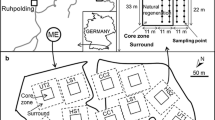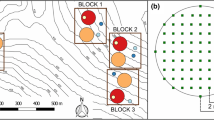Abstract
Plant-soil-water relations of a silvopastoral system composed of a Douglas-fir (Pseudotsuga menziesii) timber crop, subterranean clover (Trifolium subterraneum) as a nitrogen-fixing forage, and tall fescue (Festuca arundinacea) as a forage crop were investigated near Corvallis, Oregon, during 1983–1986. Treatments included all possible combinations of two tree-planting patterns (trees planted 2.4 m apart in a grid, and groups of five trees spaced 7.6 m between clusters) and two grazing/understory management systems (agroforests were seeded to subclover and grazed by sheep; forests were unseeded and ungrazed).
Mean twig xylem water potential (XWP) for Douglas-fir trees ranged from −0.3 to −1.5 MPa on forest plots and from −0.3 to −1.2 MPa on agroforest sites. Pre-dawn and sunset XWP were more negative for forest than for agroforest plots during dry summer periods. Midday XWP was similar for both agroforest and forest plots on all dates. Soil water content at 50–100 cm depth was greater under agroforest plots as compared to forest plots in 1984, but not in 1985 (unusually dry spring). Average foliage nitrogen content of tree needles was 1.54% vs. 1.43% for agroforests vs. forests, respectively.
Our data are consistent with the hypotheses that: (1) grazing of understory vegetation may reduce water stress of trees during dry periods by reducing transpirational water use by the forage plants; and (2) nitrogen-fixing vegetation combined with grazing increases nitrogen uptake of associated trees. However, neither mean foliar N nor average XWP differences experienced by trees in agroforest versus forest plantations were sufficient to have an effect on tree growth. Our data demonstrate that it is possible to produce a second crop (i.e. forage grazed by sheep) in timber plantations without reducing the growth of the main tree crop.
Similar content being viewed by others
References
Anonymous (1986) Local climatological data for Corvallis, Oregon. Oregon State University, Agric Exp Sta Spec Rep 777
AOAC (1984) Official Methods of Analyses (14th ed). Assoc Agr Chem, Washington DC, 156 pp
Ball R, Keeney DR, Theobald PW and Nes P (1979) Nitrogen balance in urine-affected areas of a New Zealand pasture. Agron J 7: 309–314
Batini FE, Anderson GW and Moore R (1983) The practice of agroforestry in Australia. In: Hannaway DB, ed, Foothills for Food and Forests, pp 233–246. Timber Press, Beaverton, OR, 383 pp
Carlson DH (1987) Effects of grazing management and tree planting pattern in a young Douglas-fir agroforest, MS thesis, Oregon State University, Corvallis, OR, 168 pp
Cleary BD (1971) The effect of plant moisture stress on the physiology and establishment of planted Douglas-fir and ponderosa pine seedlings. PhD dissertation, Oregon State University, Corvallis, OR, 85 pp
Cleary BD, Greaves RD and Hermann RK (eds) (1978) Regenerating Oregon's Forests. Oregon State University, Ext Sery, Corvallis, OR, 286 pp
Cole EC and Newton M (1986) Nutrient, moisture, and light relations in 5-year-old Douglasfir plantations under variable competition. Can J For Res 16: 727–732
Crider FL (1955) Root-growth stoppage resulting from defoliation of grass. USDA Tech Bull 1102. Washington, DC
Dawson, JO (1983) Dinitrogen-fixing plant symbiosis for combined timber and livestock production. In: Hannaway DB, ed, Foothills for Food and Forests, pp 95–112. Timber Press, Beaverton, OR 383 pp
Doescher PS, Tesch SD and Drewien WE (1989) Water relations and growth of conifer seedlings during three years of cattle grazing on a southwest Oregon plantation. Northwest Sci 63: 232–240
Eissenstat DM and Mitchell JE (1983) Effects of seeding grass and clover on growth and water potential of Douglas-fir seedlings. For Sci 29: 166–179
Emmingham WH and Waring RH (1977) An index to photosynthesis for comparing forest sites in western Oregon. Can J For Res 7: 165–174
Franklin JF and Waring RH (1979) Distinctive features of the northwestern coniferous forest: development, structure, and function. In: Waring RH, ed, Forests: Fresh Perspectives from Ecosystem Analysis, pp 59–86. Oregon State University Press, Corvallis, OR 199 pp
Geist, JM (1976) Forested range fertilization in eastern Oregon and Washington. Rangeman's J 3: 116–118
Gillingham AG (1983) The role of the grazing animal in nutrient cycling in hill pastures and implications for management. In: Hannaway DM, ed, Foothills for Food and Forests, pp. 73–94, Timber Press, Beaverton, OR, 383 pp
Hall FC, Hedrick DW and Keniston (1959) Grazing and Douglas-fir establishment in the Oregon white oak type. J. Forestry 57: 98–103
Halls LK (1958) Coordination of cattle grazing and timber growing on southern coastal plain forests. Proc Soc Am Foresters: 192–195
Heichel GH (1983) Nitrogen fixation of hay and pasture legumes. In: Hannaway DB ed, Foothills for Food and Forests, pp 113–125. Timber Press, Beaverton, OR, 383 pp
Heinz J (1984) The use of grass-legume seeding mixtures and mixtures and domestic sheep grazing as vegetative management tools in Oregon coastal clearcuts. Bureau of Land Management, Salem District Office, Dec, 32 pp
Hodgkinson KC and Baas Becking HG (1977) Effect of defoliation on root growth of some arid zone perennial plants. Aust J Agr Res 29: 31–42
Jaindl RG and Sharrow SH (1988) Oak/Douglas-fir/sheep: a three-crop silvopastoral system. Agroforestry Systems 6: 147–152
Karl MG and Doescher PS (1993) Regulating competition on conifer plantations with prescribed cattle grazing. For Sci 39: 405–418
Kaufmann MR and Thor GL (1982) Measurement of water stress in subalpine tress: effects of temporary tissue storage methods and needle age. Can J For Res 12: 969–972
Knezevich CA (1975) Soil Survey of Benton County Area, Oregon. USDA, Soil Conserv Serv, Albany, 119 pp
Knight PJ (1973) Influence of nitrogen supply on the growth and branching habit ofPinus radiata seedlings. N Z J For 18: 273–278
Lamouri A (1987) Assessment of a Douglas-fir/sheep silvopastoral system in western Oregon. MS thesis, Oregon State University, Corvallis, OR, 81 pp
Lavender DP (1970) Foliar analysis and how it is used: a review. Oregon State University, School of Forestry Note 52, Corvallis, OR, 8 pp
Lavender DP and Walker RB (1979) Nitrogen and related elements in nutrition of forest trees. In: Gessel SP, Kenady RM and Atkinson WA, eds, Proc Forest Fert Conf, University of Washington, pp 15–22. Inst Forest Resources Contrib No 40, Union, WA
Leininger WC (1984) Silvicultural impacts of sheep grazing in Oregon's Coast Range. PhD dissertation, Oregon State University, Corvallis, OR, 203 pp
NcNaughton SJ, Wallace LA and Coughenour MB (1983) Plant adaptation in an ecosystem context: effects of defoliation, nitrogen, and water on growth of an African C4 sedge. Ecol 64: 307–318
Miller RE and Murray MD (1978) The effects of red alder on growth of Douglas-fir. In: Briggs DC, ed, Utilization and Management of Alder, pp. 283–306. USDA, Forest Serv, Gen Tech Report PNW-70
Motazedian I and Sharrow SH (1987) Persistence of aLolium perenne—Trifolium subterraneum pasture under differing defoliation treatments. J Range Manage 40: 232–236
Newton M and Preest DS (1988) Growth and water relations of Douglas-fir (Pseudotsuga menziesii) seedlings under different weed control regimes. Weed Sci 36: 653–662
Osealt DL, Bertrand AR and Teel MR (1959) Influence of nitrogen fertilization and clipping on grass roots. Soil Sci Soc Am Proc 23: 228–230
Rawls WJ and Brakensiek DL (1982) Estimating soil water retention from soil water properties. Trans ASAE 108: 166–171
Reid D (1983) The combined use of fertilizer nitrogen and white clover as nitrogen sources for herbage growth. J Agric Sci Camb 100 613–623
Running SW (1976) Environmental control of leaf water conductance in conifers. Can J For Res 6: 104–112
Sands R and Nambiar EKS (1984) Water relations ofPinus radiata in competition with weeds. Can J For Res 14: 233–237
Vaughn CE and Murphy AH (1982) Long-term effects of fertilization and subclover seeding on northern California annual range. J Range Manage 35: 92–95
Waller, RA and Duncan DB (1969) A Bayes rules for the symmetric multiple comparison problem. J Am Stat Assoc 64: 1484–1503
Waring HD and Snowdon P (1985) Clover and urea as sources of nitrogen for establishment ofPinus radiata. Aust For Res 15: 115–124
Waring RH and Cleary BD (1967) Plant moisture stress: evaluation by pressure bomb. Science 155: 1248–1254
Whitehead DC (1970) The Role of Nitrogen in Grassland Productivity. Commonwealth Agric Bureau, Bull 48, Bucks, UK, 202 pp
Wraith JM, Johnson DA, Hanks RJ and Sisson DV (1987) Soil and plant water relations in a crested wheatgrass pasture: response to spring grazing by cattle. Oecologia 73: 573–578
Youngberg CT (1959) The influence of soil moisture on the survival of planted Douglas-fir seedlings on clay soils. J For 57: 842–844
Author information
Authors and Affiliations
Additional information
Submitted as Oregon Agrocultural Experiment Station Technical Paper No. 10109.
Rights and permissions
About this article
Cite this article
Carlson, D.H., Sharrow, S.H., Emmingham, W.H. et al. Plant-soil-water relations in forestry and silvopastoral systems in Oregon. Agroforest Syst 25, 1–12 (1994). https://doi.org/10.1007/BF00705702
Issue Date:
DOI: https://doi.org/10.1007/BF00705702




